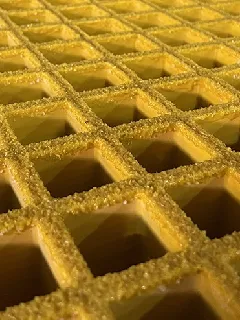loading...
- No. 9, Xingyuan South Street, Dongwaihuan Road, Zaoqiang County, Hengshui, Hebei, China
- admin@zjcomposites.com
- +86 15097380338
- Welcome to visit our website!
gfrp grating
Understanding GFRP Grating Applications and Benefits
Glass Fiber Reinforced Polymer (GFRP) grating is an innovative material that has gained significant attention in various industries due to its unique properties and advantages. Made from a composite of glass fibers and resins, GFRP grating combines the strength of glass fibers with the durability of polymer, resulting in a lightweight, corrosion-resistant, and versatile product. This article delves into the applications and benefits of GFRP grating across different fields.
Applications of GFRP Grating
1. Industrial Flooring and Walkways GFRP grating is widely used in industrial environments, such as chemical plants, oil refineries, and wastewater treatment facilities. Its resistance to chemicals and low maintenance requirements make it an ideal choice for flooring and walkways where exposure to harsh substances is common. The non-slip surface of GFRP grating provides safety for workers in potentially hazardous environments.
2. Bridges and Platforms Due to its high strength-to-weight ratio, GFRP grating is increasingly used in the construction of bridges and viewing platforms. It allows for lighter structures without compromising structural integrity. This advantage not only reduces the cost of construction but also facilitates ease of installation, especially in remote or challenging locations.
3. Marine Applications The marine industry utilizes GFRP grating for docks, piers, and platforms due to its exceptional resistance to seawater, UV radiation, and other environmental factors. Its lightweight nature makes it easier to transport and install while providing a durable and safe surface for activities such as fishing or boat maintenance.
4. Architectural Features GFRP grating is often employed in architectural designs for aesthetic and functional purposes. It can be used in staircases, balustrades, and decorative facades. Designers appreciate its versatility, as it can be manufactured in various colors, textures, and patterns, allowing for customization that meets specific design requirements.
5. Transportation Infrastructure GFRP grating is an excellent choice for pedestrian bridges, bus shelters, and airport facilities. Its lightweight properties contribute to more efficient designs, while its durability ensures longevity even in high-traffic areas. GFRP grating also offers a maintenance-free solution, which can greatly reduce lifecycle costs.
gfrp grating

Benefits of GFRP Grating
1. Corrosion Resistance One of the most significant benefits of GFRP grating is its resistance to corrosion. Unlike traditional materials like steel, which can rust and degrade over time, GFRP maintains its structural integrity when exposed to moisture, chemicals, and environmental stressors. This characteristic extends the lifespan of installations and minimizes the need for repairs.
2. Lightweight yet Strong GFRP grating's lightweight nature simplifies transportation and installation. Despite its lightness, it possesses remarkable strength, allowing it to support significant loads without bending or breaking. This property makes it suitable for applications where weight is a critical factor.
3. Safety GFRP grating is designed with various safety features in mind. Its anti-slip surface provides traction underfoot, reducing the risk of slips and falls, particularly in wet or oily conditions. Additionally, GFRP does not splinter, making it a safer option for locations where bare feet are common, such as pools or spas.
4. Low Maintenance The durability and corrosion resistance of GFRP grating lead to lower maintenance costs over time. Unlike metal grating, which may require regular painting or treatments to prevent rust, GFRP grating maintains its appearance and functionality with minimal upkeep.
5. Environmental Friendliness GFRP grating is often considered an environmentally friendly material. Many manufacturers utilize recycled content in the production of GFRP, reducing the overall environmental impact. Additionally, its long lifespan and low maintenance needs contribute to sustainability efforts in construction and infrastructure development.
In conclusion, GFRP grating offers a wealth of advantages across multiple industries, making it a desirable choice for modern applications. As technology continues to evolve, so too will the uses of GFRP grating, paving the way for innovative solutions in construction, engineering, and design.
-
The Rise of FRP Profiles: Strong, Lightweight, and Built to LastNewsJul.14,2025
-
SMC Panel Tanks: A Modern Water Storage Solution for All EnvironmentsNewsJul.14,2025
-
GRP Grating: A Modern Solution for Safe and Durable Access SystemsNewsJul.14,2025
-
Galvanized Steel Water Tanks: Durable, Reliable, and Ready for UseNewsJul.14,2025
-
FRP Mini Mesh Grating: The Safer, Smarter Flooring SolutionNewsJul.14,2025
-
Exploring FRP Vessels: Durable Solutions for Modern Fluid HandlingNewsJul.14,2025
-
GRP Structures: The Future of Lightweight, High-Performance EngineeringNewsJun.20,2025
